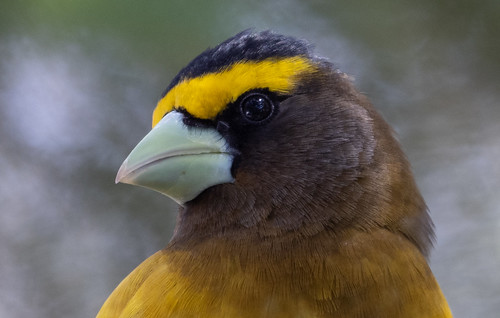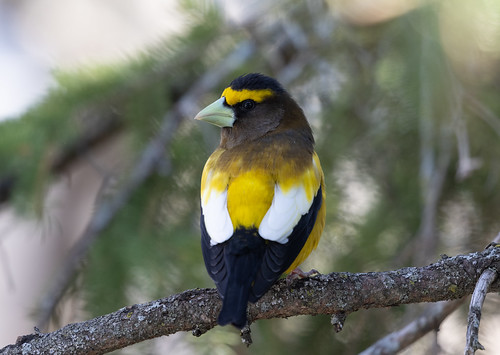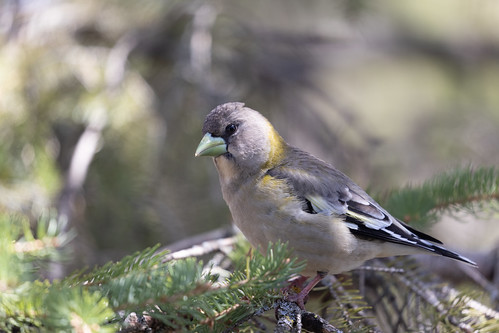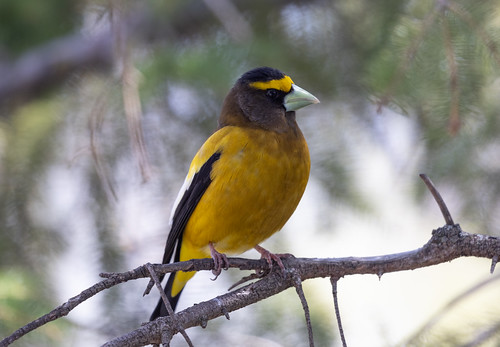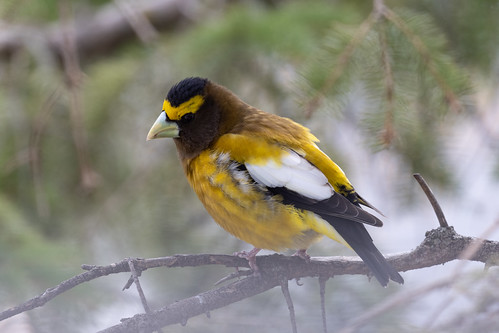Sunday morning, April 25, 2021, when I was working at my desk, a bit of movement out the window caught my eye and whoa! There were two Evening Grosbeaks, a female and a male, in my window feeder. I wasn’t quick enough to photograph them—my camera was across the room, and when I went to get it, they flew off.
They didn’t go too far—I looked out my window to see them next door, and when I opened the window to take a distant photo, I heard closer ones calling, too—and those were MUCH closer!
My home office is upstairs. The window I have easy access to is close to a boxelder on the left and a Norway spruce with outer branches reaching less than three feet from the window on the right. And at least four Evening Grosbeaks were perched in the spruce, and a couple more in the spruce next to that.
I took a bazillion photos and also set up my sound recorder in the less-accessible window. I have to crawl under my standing desk to set that up, but that was both easy and well worth the trouble—I ended up with a 50-minute stereo recording at nice close range.
Evening Grosbeaks used to be year-round, almost everyday birds in my yard, and their decline since the early 90s has been very painful for me, because they were part of our neighborhood soundtrack almost year-round since the very day Russ and I moved into our house. When Russ and I rented video cameras to take movies of our children when they were small, Evening Grosbeaks were calling in the background whenever the kids were outside.
 |
| Our backyard on May 18, 1982. |
In 2011, Russ and I had a flock of three or four family groups totaling 16 individuals every day from August 4 through September 15, but other than that, until this year I haven’t had more than a few flying over or stopping for just a quick bite at the feeder since the mid-90s.
There’s lots of evidence supporting two explanations for their decline. They feed their young enormous quantities of spruce budworm when those larvae are available, and forest managers have been spraying heavily over a wide part of the Evening Grosbeaks’ range, protecting some balsams and spruces at the expense of Evening Grosbeaks and several warblers who pig out voraciously on the budworms. Forest managers have also shortened rotation cycles in northern forests to manage for wood fiber rather than saw lumber, reducing the number of hardwoods in the grosbeak’s range, when maple and boxelder seeds are a very important component of the grosbeak diet.
Other problems contributed to the decline as well. In a 1989 paper, Daniel Klem listed Evening Grosbeaks as the 10th most common bird killed at windows. And they’re also hit by cars in large numbers in winter, when they come down to pick up grit and road salt.
Evening Grosbeaks, like other northern finches, have a cyclic component to their population numbers, and some people have postulated that the species hit an exceptionally abnormal high for a couple of decades beginning in the 70s before dropping to normal lows again. Indeed, some people question how much Evening Grosbeaks were even found in the eastern half of the continent before the 1920s except for one major irruption into the East in the 1880s, while they’ve always been known to be common breeders in the West.
But the type specimen was not collected in the West—it was taken in Sault Ste. Marie, Michigan, in April 1823, and Thomas Sadler Roberts mentioned them being fairly common up here in his Birds of Minnesota, published in 1932. In 1940, a researcher named James Bailey documented summer records forming an almost continuous belt from southeastern Manitoba to eastern Ontario, so breeding as far east as Minnesota, Wisconsin, and Michigan was almost certainly regular going back way before the 1970s. Indeed, there is an Ojibwe name for the species, suggesting that people in the know were seeing Evening Grosbeaks in the Upper Midwest for a very long time.
On Sunday, there were a total of 12 grosbeaks in my yard, I think 6 females and 6 males, and each one I saw well had a green beak, meaning they’re pretty much ready for breeding. I got a glimpse at a male feeding a female behind too many branches to take a photo, and a second male approached that same female with his tail raised and wings lowered in courting posture. In an exciting scene, the grosbeaks suddenly quieted down and a Merlin flew by. I have a 2-minute recording of that little scene. I also watched at least two different females make a call I’d never heard before—a single soft, slurred wink note that, in the context of the louder regular grosbeak calls, reminded me a bit of the tiny gulp woodcocks make before their “peent.” I didn’t see any males make that call, but that doesn't mean anything unless I can document a lot more watching them at close range. So far I haven’t been able to find documentation of the vocalization in the literature. The two sound recordings I made include examples, but I also extracted a 7-second recording that includes a few of them without too much other song (because the Merlin was near).
 |
| Click on this sonagraph to make it larger. The four darkest marks, little lines curving to the right at the very bottom, are the vocalizations I never noticed before. |
This year, grosbeak sightings have been more frequent and widespread in northern Minnesota than they’ve been in years. My friend Dudley Edmondson, who lives a few blocks away from me in the same neighborhood, has had a bigger flock for a couple of weeks. It’ll be interesting to see if any of these birds breed in or near Duluth this year—I’ll sure be paying attention around my yard. Evening Grosbeaks are one of my favorite birds, and when they’re anywhere near, attention must be paid.
